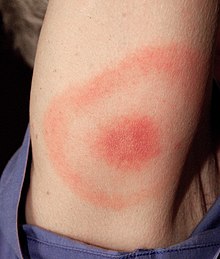Erythema (from Greek erythros 'red') is redness of the skin or mucous membranes, caused by hyperemia (increased blood flow) in superficial capillaries.[1] It occurs with any skin injury, infection, or inflammation. Examples of erythema not associated with pathology include nervous blushes.[2]
This article needs additional citations for verification. (December 2009) |
| Erythema | |
|---|---|
 | |
| Characteristic "bull's eye" rash (erythema migrans) of early Lyme disease | |
| Specialty | Dermatology |
Types
Causes
It can be caused by infection, massage, electrical treatment, acne medication, allergies, exercise, solar radiation (sunburn), photosensitization,[3] acute radiation syndrome, mercury toxicity, blister agents,[4] niacin administration,[5] or waxing and tweezing of the hairs—any of which can cause the affected capillaries to dilate, resulting in redness. Erythema is a common side effect of radiotherapy treatment due to patient exposure to ionizing radiation.
Diagnosis
Erythema disappears on finger pressure (blanching), whereas purpura or bleeding in the skin and pigmentation do not. There is no temperature elevation, unless it is associated with the dilation of arteries in the deeper layer of the skin.[citation needed]
See also
References
External links
Wikiwand in your browser!
Seamless Wikipedia browsing. On steroids.
Every time you click a link to Wikipedia, Wiktionary or Wikiquote in your browser's search results, it will show the modern Wikiwand interface.
Wikiwand extension is a five stars, simple, with minimum permission required to keep your browsing private, safe and transparent.
